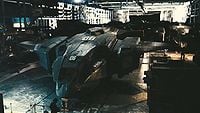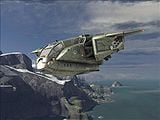D77-TC Pelican
From Halopedia, the Halo wiki
Template:Ship The Dropship 77-Troop Carrier Pelican (abbreviated D77-TC) is an extremely versatile craft used by the United Nations Space Command, mainly for the extraction and transportation of personnel, vehicles and equipment, although it can also be used as a powerful gunship.
Background
It is the UNSC's primary tactical support aircraft, fulfilling the role of tactical transport and gunship since, at least, 2525. The Pelican's crew compartments can be sealed and the craft made suitable for limited space flight. They are mainly responsible for flying in the heaviest equipment and troops, as well as rescuing from hot landing zones.
Standard armament consists of one class-three externally powered projectile weapon at the fore of the vehicle and one class-one gas operated projectile weapon mounted at the rear in the extended crew area. More heavily armed versions exist.[1]
In Halo: Custom Edition, you can pilot the Pelican in certain maps. They operate the same way as in the game such as picking and dropping vehicles, capable of vertical and horizontal lift off and also available with rocket pods and chain-gun.
Payload Capacity
The Pelican can carry passengers and cargo using a combination of internal and external methods. Specifically, the main compartment of the Pelican (called the "Blood Tray"[2]), has seats for ten people, with additional space for standing.
The internal bay amidship is the simplest way of transporting supplies and personnel and the occasional Mongoose as seen on "The Covenant". The default configuration provides seating for up to ten people.
The large aft overhang provides an attachment point for additional (and possibly oversized) cargo and ordnance. Possible payloads include a troop-bay extension, a Scorpion Tank, a Warthog, eight Resupply Canister Type-B Capsules. Maximum payload 70 tons.
Weapon Systems
Standard armament consists of a chin-mounted 40mm model which was common prior to 2525 but was later superseded by a 70mm weapon. Some dropships boasted twin chain guns firing depleted uranium slugs, although there didn't appear to be any on the Pelicans in Halo: CE.[3].
Missile pods, each holding eight ANVIL-II ASMs, can be mounted under each wing to engage more maneuverable or better protected targets. Fire control was typically delegated to the co-pilot, who was assisted by helmet-mounted display.
A machine gun or 25mm grenade launcher can also be mounted facing out of the rear cargo hatch and folded flat against the roof of the internal bay when not in use by the crew chief or passenger.
Propulsion
The main engines are mounted in pairs in four nacelles, one on each wing and two at the rear. The nacelles can articulate independently, thus altering (ie, Vectoring) the direction of thrust and improving the dropship's low altitude maneuverability. Six ventral thrusters, two on each wing nacelle and one on each aft nacelle, allow the Pelican to land and take off vertically. These engines are capable of both space and atmospheric operation. The Pelican is too small to have a translight engine mounted on it.
New Variant (D77H-TCI)
- Main article: D77H-TCI Pelican Dropship
Halo 3 introduces the new variant of the Pelican, D77H-TCI Pelican (The H stands for Heavy, the I probably stands for Infantry). Externally, it appears nearly identical to the Pelicans used in Halo: CE and Halo 2. The missile pods have been replaced with a different version. Instead of an attachable box-like pod, it's now attached directly to the wings and engines (although some Pelicans still opt out the missile pod). The chaingun has been left out of the design altogether. Internally, though, the craft has been renovated: it can store equipment in overhead netting. It also mounts an AIE-486H Heavy Machine Gun at the opening of the troop-bay for suppression fire during insertion/extraction missions. The cockpit has been altered, and instead of the side-by-side positioning of the pilot and co-pilot, the pilot now sits at the fore of the dropship, with the co-pilot behind him/her, and at a higher position, in tandem.
Character Compatibility
Identified Pelicans
Pelicans receive serial numbers to be identified by during radio transmissions, particularly in combat situations. Each serial number consists of a letter from the Phonetic Alphabet followed by a number. Though a few Pelicans have this number inscribed on their cargo bays, most have no distinguishing mark on their exteriors. It is unclear how the numbers are chosen, but with their spread across the alphabet and numerals, it can be inferred that a massive number of Pelicans are in service, perhaps as many as 26,000.
See Also
- Phantom - The Covenant equivalent of the Pelican.
- Spirit - The Covenant dropship similar to the Pelican.
Trivia
- The pelican variant in Halo 1 & 2 is D77-TC, but the one in Halo 3 is D77H-TCI
- The player cannot pilot the Pelican in Halo 1, 2 and 3. However, they will be experiencing crash sites in the game to pick up supplies, such as weapons and ammo.
- The Pelicans in Halo 1 did not have any cockpits, and no pilots were visible. If a player looks closely at the front of one, there is just a flat black placeholder graphic. Halo 2 and Halo 3 Pelicans have actual cockpits, but some Halo 3 Pelicans do not have visible cockpits, due to tinted windows.
- The original Pelican model is similar to the UD-4L Cheyenne Dropship from the movie Aliens.
- Pelicans in Halo 1, 2 and Halo 3 are never seen carrying more than six human Marine troops at a time, despite being capable of carrying up to fifteen. However, it is likely that this is merely because UNSC troops usually work in small teams during engagements, comprising of 5 to 6 men, known as Fire Teams. Another likely reason is that the Master Chief, in full armor, weighs in at about 1000 lbs, making him weigh approximately as much as 5 fully armed marines. So 6 marines, plus the weight of 5 means the Pelican is towing the average of 11, as Halo: The Flood stated, 15 is more than pushing the limit as it is.
- The only time a Pelican is seen full of marines in the entire Halo series is in Halo 3 on the Crows Nest level. If you rescue all the marines in the barracks and keep them alive until the Pelican rescues them on the landing pad, all of them (5-7 maximum) plus the Arbiter, Johnson, and his squad of 1-3 marines will board. Johnson will sometimes sit down instead of standing, filling up all the seats.
- In Halo CE on Assault on the Control Room, if you hold down X (E on PC by default) at the beginning of the level you can stay inside the Pelican but beware because soon it goes down and you die.
- Although in Halo 2 the Pelican carries two missile pods, each loaded with 8 Anvil-II High Explosive missiles, the only time the dropships ever use them in combat is during the end of the level 'Metropolis', when some launch them against a Scarab, and at the beginning of Delta Halo, when Johnson's Pelican launches some if there are any Covenant left when the Pelicans come in. It is also used in Quarantine Zone, after you first encounter a Scorpion. When you move to the next section, a Pelican (unknown if human or Flood controlled) will fire missiles as it passes by at either you or the Sentinels. Its 70mm chain gun, on the other hand, is used twice during 'Outskirts', both times against Jackals. Also, in the level Delta Halo, when the Pelican drops off the Scorpion, if there are any Covenant troops left alive, the Pelican will attack them with its chain gun. On occasion the Pelican also attacks the Banshees when they are on approach to the player's position.
- The Pelican resembles the real life V-22 Osprey in uses (troop deployment and light ground attack) and design (vertical and horizontal flight, forward cockpit rear troop bay and engines mounted in outer nacelles).
- In both Halo 2 and Halo 3, the Pelicans are also used for ammo drops, carrying 6 cylindrical weapon canisters instead of a Warthog or Scorpion. These are found throughout Delta Halo and Regret in Halo 2, as well as a couple of scripted drops. These canisters cannot harm the player unless s/he is positioned directly underneath, but they can destroy a vehicle if they hit it. In Halo 3, the canisters are encountered less, and mostly while on The Ark. However in Halo 3, they only drop 4 at one time.
- The pods dropped off can be moved by driving into them with a vehicle, mostly tanks.
- It's implied that Pelicans have a Gravity Stabilizer of some sort for in the first cut scene on The Ark it shows the Pelicans in near ark orbit and if they did not have a stabilizer Master Chief and the ODST would be floating around.
- In Halo 2, you can get in one in the Metropolis level. Before you enter the building, and the Scarab walks over you, stand on the bridge, under where the Pelican would come, that the Pelican drops off people, hold X and you will go for a ride.
Glitch
It is possible to take down the Pelican that picks the player up in the end of Sierra 117. When it flies over the dam, stick its window with a plasma grenade. If it hits perfectly, the pilot will die and the Pelican will fall down. This may take several tries. Easy or normal difficulty is recommended, and Cowbell skull may help. Note: The level is unbeatable after this glitch, unless you revert to saved.
Images
- PelicanII-Sil.gif
- K30 1.jpg
A Pelican, moments before exploding after it is hit by plasma from a Covenant Loyalist Seraph-class starfighter.
- Pelican.png
Inside the cockpit of a Halo 3 Pelican.
Sources
- ^ halo3.com
- ^ Halo: Ghosts of Onyx, page 203
- ^ Halo: Ghosts of Onyx, page 40

